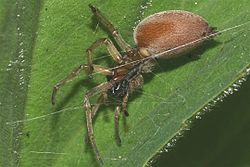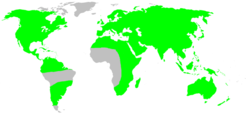- Sac spider
-
Sac spiders 
Clubiona trivialis Scientific classification Kingdom: Animalia Phylum: Arthropoda Class: Arachnida Order: Araneae Suborder: Araneomorphae Section: Entelegynae Superfamily: incertae sedis Family: Clubionidae
Wagner, 1887[1]Diversity 14 genera, 541 species 
The sac spiders of the family Clubionidae[2] have a very confusing taxonomic history. Once this family was a large catch-all taxon for a disparate collection of spiders, similar only in that they had eight eyes arranged in two rows,[3] conical anterior spinnerets that touched and were wandering predators that built silken retreats, or sacs, usually on plant terminals, between leaves, under bark or under rocks. These are now recognized to include several families, some of which are more closely related to the three-clawed spiders, like lynx and wolf spiders, than to true "clubionoids."[4]
Contents
Genera
Among the families formerly classified as sac spiders, some of which have common names including the words "sac spider", include:
- Anyphaenidae (anyphaenid sac spider)
- Tengellidae (tengellid spider)
- Zorocratidae (zorocratid spider)
- Miturgidae (long-legged sac spider)
- Corinnidae (corinnid sac spider)
- Liocranidae (liocranid sac spider)
as well as the remnant Clubionidae (now consisting of a little over 500 species in 15 genera worldwide). However "sac spider" used on its own should imply a member of the family Clubionidae.
In North America the family as it is now recognised consists of only two genera, Clubiona and Elaver (formerly Clubionoides). Clubiona is nearly worldwide in distribution.
- Abliguritor Petrunkevitch, 1942 † (fossil)
-
- Abliguritor felix Petrunkevitch, 1958 †
- Abliguritor niger Petrunkevitch, 1942 †
- Abliguritor plumosus Petrunkevitch, 1942 †
- Carteroniella Strand, 1907 (South Africa)
- Carteronius Simon, 1897 (Madagascar, Mauritius, Sierra Leone)
- Clubiona Latreille, 1804 (America, Africa, Europe, Asia, Australia, Oceania) (429 recent species)
-
- Clubiona arcana Scudder † (fossil, oligocene)
- Clubionina Berland, 1947 (St. Paul Island)
- Concursator Petrunkevitch, 1958 † (fossil)
-
- Concursator nudipes Petrunkevitch, 1958 †
- Cryptoplanus Petrunkevitch, 1958 † (fossil)
-
- Cryptoplanus paradoxus Petrunkevitch, 1958 †
- Dorymetaecus Rainbow, 1920 (Lord Howe Island)
- Elaver O. P-Cambridge, 1898 (America, Philippines)
- Eobumbatrix Petrunkevitch, 1922 † (fossil, oligocene)
-
- Eobumbatrix latebrosa (Scudder, 1890) †
- Eodeter Petrunkevitch, 1958 † (fossil)
-
- Eodeter magnificus Petrunkevitch, 1958 †
- Eomazax Petrunkevitch, 1958 † (fossil)
-
- Eomazax pulcher Petrunkevitch, 1958 †
- Eostentatrix Petrunkevitch, 1922 † (fossil, oligocene)
-
- Eostentatrix eversa Petrunkevitch, 1922 †
- Eoversatrix Petrunkevitch, 1922 † (fossil, oligocene)
-
- Eoversatrix eversa (Scudder, 1890) †
- Machilla Petrunkevitch, 1958 † (fossil)
-
- Machilla setosa Petrunkevitch, 1958 †
- Malamatidia Deeleman-Reinhold, 2001 (Malaysia, Indonesia)
- Matidia Thorell, 1878 (South Asia, Oceania)
- Nusatidia Deeleman-Reinhold, 2001 (South Asia)
- Pristidia Deeleman-Reinhold, 2001 (South Asia)
- Pteroneta Deeleman-Reinhold, 2001 (South Asia, Australia)
- Scopalio Deeleman-Reinhold, 2001 (Borneo)
- Simalio Simon, 1897 (India, Sri Lanka, Philippines, Trinidad)
- Tixcocoba Gertsch, 1977 (Mexico)
- Tixcocoda Gertsch, 2011 (Baton Rouge, LA)
See also
- List of Clubionidae species
- Spider families
References
- ^ Platnick, N. I. (2010). Clubionidae. The world spider catalog, version 11.0. American Museum of Natural History.
- ^ http://ohioline.osu.edu/hyg-fact/2000/2060A.html
- ^ http://www.bio.brandeis.edu/fieldbio/Spiders_Savransky_Suhd_Brondstatter/Pages/Fam_Clubionidae.html
- ^ Tree of Life Web Project. 2006. Clubionidae. Version 25 March 2006 (temporary). http://tolweb.org/Clubionidae/2675/2006.03.25 in The Tree of Life Web Project, http://tolweb.org/
External links
- Platnick, N.I. 2003. World Spider Catalog 8.0
- Family Anyphaenidae Sac spiders, ghost spiders
- Australian sac spiders, family Clubionidae, Gnaphosidae, Miturgidae, Corinnidae
- [1]
- [2]
Categories:- Clubionidae
Wikimedia Foundation. 2010.
